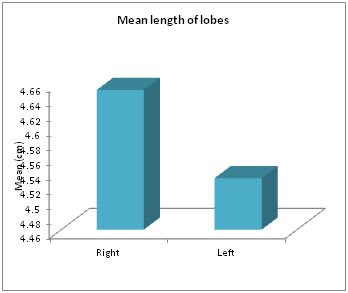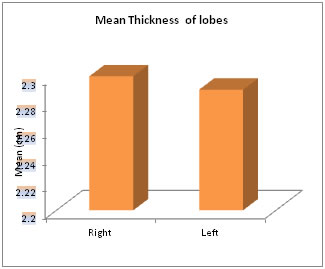|
Table of Content Volume 3 Issue 1 - July 2017
Morphological variation of thyroid gland in cadavers
M B Saknure1, C S Halnikar (Waghmare)2*
{1Assistant Professor, Department of Anatomy} {2Assistant Professor, Department of Surgery} Government Medical College, Latur, Maharashtra, INDIA. Email: mbsaknure@gmail.com
Abstract Background: The thyroid gland, largest endocrine gland. Estimation of the size of the thyroid gland is clinically important in the evaluation and management of thyroid disorder. The current emphasis on the surgical management of the thyroid disease has necessitated the understanding of the embryology and anatomy of the thyroid gland and other vital structures in the neck, that helps the physician to perform proper physical examination and also to the surgeon to perform successful thyroid surgeries. Thus, a thorough knowledge of the anatomy of the thyroid gland, its morphology is a prerequisite for better understanding of the thyroid gland and its diseases. Aims and Objectives: To study the morphology of thyroid gland. Material and Methods: Present study includes total 100 thyroid glands from cadavers, embalmed with 10% formalin of known sex from Medical colleges. Study Periods and Designs: Between years DEC.2012 to JAN 2014. Results: Present study shows that, mean length of right lobe was 4.65 + 0.69 cm. and that of left lobe was 4.53 + 0.65 cm. mean length of right lobe of thyroid gland was significantly more than left lobe. The thickness of lobes on right side was 2.33+0.36cm and on left side of thyroid gland was 2.29+0.44 cm. There was no difference in thickness of right and left lobes of thyroid gland. Mean Width of isthmus of thyroid gland was 3.15 cm. Conclusion: Present study shows that, mean length of right lobe of thyroid gland was significantly more than left lobe. There was no difference in thickness of right and left lobes of thyroid gland. Key Words: Morphological variation, thyroid gland, cadavers.
INTRODUCTION The thyroid gland is the largest endocrine gland. It is brownish-red and highly vascular. It is placed anteriorly in the lower neck, level with the fifth cervical to the first thoracic vertebrae. It usually weighs 25 gm, but this could vary. The gland is slightly heavier in females, and enlarges during menstruation and pregnancy. Estimation of the size of the thyroid gland is clinically important in the evaluation and management of thyroid disorders and can be achieved non-invasively by means of diagnostic ultrasound.1 The thyroid gland is the first endocrine gland to start developing in the embryo2. The thyroid gland has the greatest blood supply per unit of tissue.3 The knowledge of the various developmental anomalies of the gland and the variations in the neurovascular relations will help the surgeons the better planning of a safe and effective surgery.4 The size and shape of the thyroid gland may alter remarkably with age, gender, physiological condition, race, and geographical location. It may be larger and heavier in females than in males, and hypertrophy during menstruation and pregnancy.5 Any abnormal enlargement of the thyroid gland is called goiter. Major enlargements may be associated with either excessive or deficient production of thyroid hormones6. The thyroid gland is a notably labile gland that varies greatly in size and structure7. In the routine examinations of workers who are exposed to radiation, to give full protection against the accompanying hazards, the standard weight, size, and shape of the thyroid should be known. Furthermore, knowledge of variations of the thyroid is substantial for surgeons dealing with head and neck surgery. Therefore, training and understanding of the thyroid anatomy and its associated anatomical variations are obligatory in order not to overlook these anomalies in differential diagnosis.8
MATERIAL AND METHODS The present study was carried out in the Department of Anatomy between years Dec 2012 to Jun 2014. The project was submitted to Independent Ethical committee of our college. After getting the approval letter from Independent Ethical Committee, the study was started. Present study includes total 100 thyroid glands from cadavers, embalmed with 10% formalin of known sex (62 Males and 38 Females) from GMC, IGG MC, LMMC, Nagpur. Dissection method was employed for this study. The infrahyoid group of muscles were identified and reflected. The sternocledomastoid muscle was displaced laterally and thyroid gland was exposed. The fascia was removed from the lobes of the thyroid gland, After that, the gland was removed from cadaver and the measurements of thyroid gland were taken. The following measurements were taken from thyroid gland.
OBSERVATIONS AND RESULTS
Table 1: Length of right and left lobes of thyroid gland
Table No. 1 Shows that mean length of right and left lobe of thyroid gland. It shows that mean length of right lobe was 4.65 + 0.69 cm. and that of left lobe was 4.53 + 0.65 cm. with t value 2.3791 which was significant with P value 0.0193. That shows mean length of right lobe of thyroid gland is significantly more than left lobe. Figure 1: Bar diagram showing mean length of right and left lobes in cm
Table 2: Thickness of lobes on right and left side of thyroid gland
Table no. 2 shows the thickness of lobes on right and left side of thyroid gland. When the thickness of thyroid is compared on right it showed mean thickness of 2.33cm. with standard deviation of 0.36 which ranges from 1.3-3.7 and on left side mean thickness was 2.29 cm. with standard deviation of 0.44 which ranges from 1.3-3.0.It shows that there was no statistical difference in thickness of right and left side of thyroid gland with p value 0.5354.
Figure 2: Bar Diagram showing mean thickness of lobes (cm) Mean Width of isthmus of thyroid gland is 3.15 cm DISCUSSION Thyroid disorder is a common health problem among large number of endocrinopathies. About 5% of the world population is affected from various thyroid disorders. This requires medical and surgical intervention. There is variation in the gross anatomy of the gland. Literature also replete with a large number of variations of the thyroid gland.
Table 3: Comparison of the mean length, mean thickness of right and left lobe and width of isthmus of thyroid gland with other authors
M.L.R.L.-Mean Length of Right Lobe, M.L.L.L.-Mean Length of Left Lobe, M.T.R.L.-Mean Thickness of Right Lobe, M.T.L.L.-Mean Thickness of Left Lobe, W.I.-Width of Isthmus. Table no 3 shows comparison of morphological measurement of thyroid gland, with other authors.
CONCLUSIONS The correlation between the mean length of right and left lobe of thyroid gland was found significant with p value of 0.0193. Comparison of the thickness of lobes on right and left side of thyroid gland, it showed there was no statistical difference in thickness of right and left lobe of thyroid gland with P value 0.5354. Mean Width of isthmus of thyroid gland is 3.15 cm. Present study shows that, mean length of right lobe of thyroid gland was significantly more than left lobe. There was no difference in thickness of right and left lobes of thyroid gland. Most of the diseases affecting the thyroid gland e.g. goitre, thyrotoxicosis, adenoma, carcinoma etc. are usually associated with enlargement of the gland and require medical and surgical intervention. There are many variations in the shape, size and relative level of the thyroid gland. Therefore, knowledge of the variation in morphological and topographical anatomy is very important in the evaluation and management of the thyroid disorders in clinical practice. In order to perform safe and effective surgery as well as diagnosis of thyroid gland diseases, thyroid anatomy and its anatomical variation are very essential to know for endocrinologist and surgeons, so that these anomalies are not over looked while arriving at a diagnosis.
REFERANCES
|
|
 Home
Home


